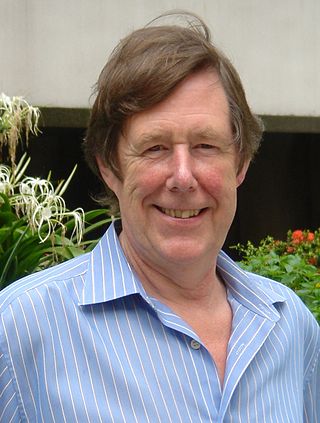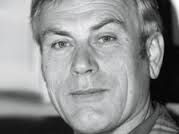
Microscopy is the technical field of using microscopes to view objects and areas of objects that cannot be seen with the naked eye. There are three well-known branches of microscopy: optical, electron, and scanning probe microscopy, along with the emerging field of X-ray microscopy.

A microscope is a laboratory instrument used to examine objects that are too small to be seen by the naked eye. Microscopy is the science of investigating small objects and structures using a microscope. Microscopic means being invisible to the eye unless aided by a microscope.

Thomas Eugene Everhart FREng is an American educator and physicist. His area of expertise is the physics of electron beams. Together with Richard F. M. Thornley he designed the Everhart–Thornley detector. These detectors are still in use in scanning electron microscopes, even though the first such detector was made available as early as 1956.

A micrograph or photomicrograph is a photograph or digital image taken through a microscope or similar device to show a magnified image of an object. This is opposed to a macrograph or photomacrograph, an image which is also taken on a microscope but is only slightly magnified, usually less than 10 times. Micrography is the practice or art of using microscopes to make photographs.

Richard Henderson is a British molecular biologist and biophysicist and pioneer in the field of electron microscopy of biological molecules. Henderson shared the Nobel Prize in Chemistry in 2017 with Jacques Dubochet and Joachim Frank."Thanks to his work, we can look at individual atoms of living nature, thanks to cryo-electron microscopes we can see details without destroying samples, and for this he won the Nobel Prize in Chemistry."

Heinrich Rohrer was a Swiss physicist who shared half of the 1986 Nobel Prize in Physics with Gerd Binnig for the design of the scanning tunneling microscope (STM). The other half of the Prize was awarded to Ernst Ruska. The Heinrich Rohrer Medal is presented triennially by the Surface Science Society of Japan with IBM Research – Zurich, Swiss Embassy in Japan, and Ms. Rohrer in his memory. The medal is not to be confused with the Heinrich Rohrer Award presented at the Nano Seoul 2020 conference.

The Swiss Nanoscience Institute (SNI) at the University of Basel is a center of excellence for nanosciences and nanotechnology in Northwestern Switzerland. It was founded in 2006 by the Canton of Aargau and the University of Basel to succeed the National Center of Competence in Research (NCCR) Nanoscale Science. and with a view to further developing and strengthening education and research in the nanosciences and nanotechnology in Northwestern Switzerland. The SNI is based on an interdisciplinary network of partner organizations and researchers who participate in basic or applied research projects and are involved in educating nanosciences students and doctoral students at the University of Basel. The SNI includes the Nano Technology Center at the University of Basel, which encompasses the Nano Imaging Lab and the Nano Fabrication Lab. These two service units provide academic institutions and industrial companies with services in the areas of microscopic imaging and analysis and nanofabrication.
Winfried Denk is a German physicist. He built the first two-photon microscope while he was a graduate student in Watt W. Webb's lab at Cornell University, in 1989.
David Bernard Williams was the dean of the College of Engineering at the Ohio State University from 2011-2021. He was previously the fifth president of the University of Alabama in Huntsville in Huntsville, Alabama from March 2007 until April 2011, and Vice Provost for Research and Harold Chambers Senior Professor of Materials Science and Engineering at Lehigh University in Bethlehem, Pennsylvania.

Colin James Richard Sheppard, usually cited as C. J. R. Sheppard, is senior scientist at the Italian Institute of Technology in Genoa, Italy. His areas of research are in optics, microscopy and imaging, including confocal and multiphoton microscopy, diffraction, 3D imaging and reconstruction, superresolution, beam propagation, and pulse propagation.
Nanosurf AG, headquartered in Liestal, Switzerland, is a developer, manufacturer and supplier of nano-microscopes for industrial and academic research, as well as for educational purposes. Nanosurf's atomic force microscopes (AFM) and scanning tunneling microscopes (STM) are used for metrological surface inspections and for the visualization of structures, and material properties on the nanometer scale.

Ondrej L. Krivanek is a Czech/British physicist resident in the United States, and a leading developer of electron-optical instrumentation. He won the Kavli Prize for Nanoscience in 2020 for his substantial innovations in atomic resolution electron microscopy.

Oded Balilty is an Israeli documentary photographer. He is an Associated Press (AP) photographer and won the Pulitzer Prize for Breaking News Photography in 2007.

Dieter Pohl is a German–Swiss physicist. He became known especially for his pioneering works in nano-optics, near field optics (NFO), and plasmonics.

Sergei V. Kalinin is a corporate fellow at the Center for Nanophase Materials Sciences (CNMS) at Oak Ridge National Laboratory (ORNL). He is also the Weston Fulton Professor at the Department of Materials Science and Engineering at the University of Tennessee-Knoxville.

Joachim Frank ; born September 12, 1940) is a German-American biophysicist at Columbia University and a Nobel laureate. He is regarded as the founder of single-particle cryo-electron microscopy (cryo-EM), for which he shared the Nobel Prize in Chemistry in 2017 with Jacques Dubochet and Richard Henderson. He also made significant contributions to structure and function of the ribosome from bacteria and eukaryotes.

Jacques Dubochet is a retired Swiss biophysicist. He is a former researcher at the European Molecular Biology Laboratory in Heidelberg, Germany, and an honorary professor of biophysics at the University of Lausanne in Switzerland.

Cryogenic electron microscopy (cryo-EM) is a cryomicroscopy technique applied on samples cooled to cryogenic temperatures. For biological specimens, the structure is preserved by embedding in an environment of vitreous ice. An aqueous sample solution is applied to a grid-mesh and plunge-frozen in liquid ethane or a mixture of liquid ethane and propane. While development of the technique began in the 1970s, recent advances in detector technology and software algorithms have allowed for the determination of biomolecular structures at near-atomic resolution. This has attracted wide attention to the approach as an alternative to X-ray crystallography or NMR spectroscopy for macromolecular structure determination without the need for crystallization.
Tatyana Tsyhanova is a Belarusian photographer known for her children images and photo portraits.

Roland Wiesendanger is a German physicist, specializing in nanoscience. Since 1993 he has been a full professor at the University of Hamburg, Germany.















